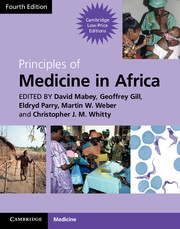Book contents
- Frontmatter
- Contents
- Contributors
- Foreword
- Section 1 Health and disease
- Section 2 Mother and child health
- Section 3 Infection: general principles
- Section 4 Major common infections
- Section 5 Bacterial infections
- Section 6 Viral Infections
- 34 Viral haemorrhagic fevers: yellow fever, Lassa fever, Rift Valley fever, Ebola/Marburg fever and Crimean–Congo fever
- 35 Dengue
- 36 Rabies
- 37 Influenza
- 38 Poliomyelitis
- 39 Varicella (chickenpox), herpes zoster and monkeypox
- 40 Rubella
- 41 Mumps
- Section 7 Protozoal infections
- Section 8 Helminth infections
- Section 9 Fungal infections
- Section 10 Non-communicable diseases
- Section 11 Diseases of body systems
- Section 12 Cancer and Palliative Care
- Section 13 Venoms and Poisons
- Index
- References
40 - Rubella
from Section 6 - Viral Infections
Published online by Cambridge University Press: 05 March 2013
- Frontmatter
- Contents
- Contributors
- Foreword
- Section 1 Health and disease
- Section 2 Mother and child health
- Section 3 Infection: general principles
- Section 4 Major common infections
- Section 5 Bacterial infections
- Section 6 Viral Infections
- 34 Viral haemorrhagic fevers: yellow fever, Lassa fever, Rift Valley fever, Ebola/Marburg fever and Crimean–Congo fever
- 35 Dengue
- 36 Rabies
- 37 Influenza
- 38 Poliomyelitis
- 39 Varicella (chickenpox), herpes zoster and monkeypox
- 40 Rubella
- 41 Mumps
- Section 7 Protozoal infections
- Section 8 Helminth infections
- Section 9 Fungal infections
- Section 10 Non-communicable diseases
- Section 11 Diseases of body systems
- Section 12 Cancer and Palliative Care
- Section 13 Venoms and Poisons
- Index
- References
Summary
Rubella or ‘little red’ is one of six classic childhood illnesses characterized by fever and a rash. It is a mild febrile illness of little direct clinical importance. It has a world-wide distribution and tends to occur in epidemics. Its main relevance is when infection occurs during the first trimester of pregnancy, when there is a high incidence of serious congenital abnormalities (WHO, 1999). This can be prevented by vaccination and, since man is the only known host, it is theoretically possible to eliminate the disease.
The problem in Africa
Rubella is not yet included in the childhood immunization strategy of any sub-Saharan country. Two-thirds of young adults have been exposed, and congenital rubella syndrome (CRS) continues to be an important and under-recognized problem, affecting 0.1–0.2 per 1000 live births (Clarke et al., 1980; Cutts et al., 1997).
Biology
Rubella is caused by a single-stranded RNA virus from the Togaviridae family, which consists of a capsid and an envelope protein with only one antigenic strain. It is transmitted by airborne droplets but can also be passed on by direct contact with recently contaminated material. Viral shedding from the upper respiratory tract begins around 10 days after infection and the incubation period is 2–3 weeks. Patients are considered to be infectious from 1 week before to 1 week after onset of the rash, and children should be excluded from school and avoid contact with pregnant women during this time. Rubella is inactivated by ultraviolet light, 1 per cent sodium hypochlorite and 70 per cent ethanol (WHO, 2007).
- Type
- Chapter
- Information
- Principles of Medicine in Africa , pp. 396 - 397Publisher: Cambridge University PressPrint publication year: 2013



